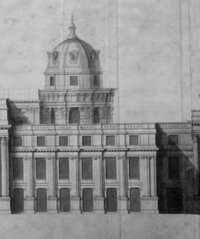Palace of Whitehall
|
|
The_Old_Palace_of_Whitehall_by_Hendrik_Danckerts.jpg
The Palace of Whitehall was the main residence of the English monarchs in London from 1530 until 1698 when all except Inigo Jones' 1622 Banqueting House was destroyed by fire. Before the fire it had grown to be the largest palace in Europe, with over 1,500 rooms.
The palace gives its name — Whitehall — to the current administrative centre of the UK government.
| Contents |
Location
At its most expansive, the palace extended over much of the area currently bordered by Northumberland Avenue in the north; to Downing Street and nearly to Derby Gate in the south; and from roughly the elevations of the current buildings facing Horse Guards Road in the west, to the then banks of the river Thames in the east (the construction of Victoria Embankment has since reclaimed more land from the Thames) - a total of about 23 acres (93,000 m²).
History
By the 13th century, the Palace of Westminster had become the centre of government in England, and had been the main London residence of the king since 1049. The surrounding area became a very popular — and expensive — location. Walter de Grey, the Archbishop of York bought a property in the area soon after 1240, calling it York Place.
Edward I of England stayed at the property on several occasions while work was carried out at Westminster, and enlarged the building to accommodate his entourage. York Place was rebuilt during the 15th century and expanded so much by Cardinal Wolsey that it was rivaled by only Lambeth Palace as the greatest house in London, the King's London palaces included. Consequently when King Henry VIII removed the cardinal from power in 1530, he acquired York Place to replace Westminster as his main London residence.
George_Vertue's_plan_of_Whitehall_Palace_in_1680_-_annotated.JPG

Henry VIII subsequently redesigned York Place, and further extended and rebuilt the palace during his lifetime. Insired by Richmond Palace, he also included a recreation centre with a bowling green, tennis courts, a pit for cock fighting (now the site of 10 Downing Street) and a tiltyard for jousting. It is estimated that over 30,000 pounds were spent during the 1540s, 50% more than the construction of the entire Bridewell Palace.
James I made a few significant changes to the buildings, notably the construction in 1622 of a new Banqueting House built to a design by Inigo Jones to replace a series of previous banqueting houses dating from the time of Elizabeth I. Its decoration was finished in 1634 with the completion a ceiling by Sir Peter Paul Rubens, commissioned by Charles I (who was to be executed in front of the building in 1649). By 1650 the Palace was the largest complex of secular buildings in England, with over 1,500 rooms. The layout was extremely irregular and the constituent parts were of many different sizes and in several different architectural styles. The palace looked more like a small town than a single building.
Charles II commissioned minor works. Like his father, he died at the Palace — though from a stroke, not execution. James II ordered various changes by Sir Christopher Wren, including a new chapel finished in 1687, rebuilding of the queen's apartments (1688?), and the queen's private lodgings (1689).
Demise
In 1691, when the palace was the largest palace complex in Europe — and a jumble of buildings — a fire destroyed much of the older palace structures. This actually gave a greater cohesiveness to the complex. However a further fire on January 4, 1698 destroyed most of the other residential and government buildings. Despite some rebuilding, financial constraints prevented large scale rebuilding. In the second half of the eighteenth century, much of the site was leased for the construction of town houses.
The palace today
The 1622 Banqueting House is the only building now remaining, although it has been somewhat modified. However, various other features of the old palace still exist, including a former covered tennis court from the time of Henry VIII in the Cabinet Office at 70 Whitehall.
Beginning in 1938, the east side of the site was redeveloped with the building now housing the Ministry of Defence. An undercroft from Wolsey's Great Chamber, now known as Henry VIII's Wine Cellar survives in the basement of this building, having been relocated nine feet to the west and nearly 19 feet deeper, when building was resumed at the site shortly after World War II.
A number of marble carvings from the former chapel at Whitehall (which was built for James II), can now be seen in the church at Burnham on Sea in Somerset, to where they were moved in 1820 after having originally been removed to Westminster Abbey in 1706.
See also
- List of Palaces
- Palace of Westminster - Main London royal residence from 1049 until 1530
- Palace of Whitehall - Main London royal residence from 1530 to 1698
- St. James's Palace - Main London royal residence from 1702 until 1837
- Buckingham Palace - Main London royal residence since 1837
External links
- Palace of Whitehall Timeline (http://www.hrp.org.uk/webcode/timeline.asp?ID=73)fr:Palais de Whitehall
